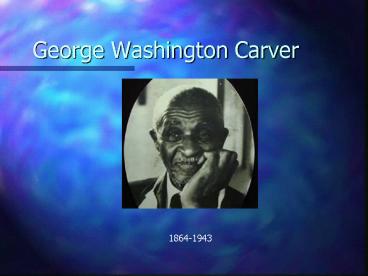George Washington Carver - PowerPoint PPT Presentation
1 / 11
Title:
George Washington Carver
Description:
Adopted by his owner, Moses Carver, and treated as one of Moses' own. ... He was offered large sums of money to work for Thomas Edison and Henry Ford. ... – PowerPoint PPT presentation
Number of Views:310
Avg rating:3.0/5.0
Title: George Washington Carver
1
George Washington Carver
1864-1943
2
Georges Childhood
- Born a slave during the civil war to the Carver
family. Him and his mother were both kidnapped.
He was recovered but his mother was never found. - Adopted by his owner, Moses Carver, and treated
as one of Moses own. - Was a weak child who suffered from whooping cough
possibly due to a tuberculosis or pneumonia. - As a result, he was never subjected to hard labor
and instead was free to pursue his own interests
most of the time which was caring for plants.
3
Georges Schooling
- Not allowed to attend school in Diamond because
of his race, George moved to Neosho and stayed
with a black family, Mariah and Andrew Watkins. - 1870s, He moved to Fort Scott, KS for more
schooling. After seeing a black man burnt alive
by an angry mob, he fled the horror to Olathe,
KS. - 1884, He was accepted by mail to Highland
College. He got there only to find out that they
didnt accept blacks. Discouraged, George didnt
apply to another college for the rest of the
decade.
4
In Between
- 1886, Moved to Ness County to help a white
settler, George Stealey. - 1887, George had his own house and made a meager
living farming. He continued to experiment with
plants. His white neighbors were astonished by
his obvious talents and he quickly gained their
respect. Many held the opinion that - if not for his dusky skin, he might occupy a
different sphere to which his ability would
otherwise entitle him
5
Back to School
- At the age of thirty, He gained acceptance into
Simpson College in IA where he majored in Art but
studied horticulture as well. Encouraged by his
art teacher, he applied and was accepted to Iowa
State. - 1894, He became the first African American to
graduate. - He was then made an instructor, making him the
first Black faculty member - He continued research on the fungi that were
attacking wheat, soybeans, oats, blackberries,
and maple trees. He had his masters within 2
years.
6
Georges Discoveries
- 1896, Invited by Booker T. Washington to teach at
Tuskegee Institute in Alabama. (George worked
there for the rest of his life). - While there, He developed the system of crop
rotation. The system was so successful it
resulted in an oversupply of peanuts. - In order to make the supply profitable, he began
searching for uses for the peanuts and other
large crops. Throughout his lifetime, he created
about 325 uses of peanuts, 108 for sweet
potatoes, and 75 for pecans. Also 118 products
and over 500 dyes and pigments from 28 different
plants.
7
Worldwide recognition
- Georges accomplishments were well known around
the world and many important people sought his
advice, for example - Mahatma Ghandi wanted guidance on building and
maintaining an agricultural system. - Joseph Stalin inquired on how to exploit the
fertility of the land in the former U.S.S.R. - George also developed peanut milk which saved the
lives of hundreds of babies in West Africa
8
Not In It For The Money
- He was offered large sums of money to work for
Thomas Edison and Henry Ford. He always rejected
such offers saying If I took the money, I might
forget my people. - George also never patented most of his
discoveries. His reasoning was that God gave
them to me, how can I sell them to someone else?
9
Inspired Methods
- Carver was a deeply religious man applying
religious values such as justice to the poor and
humility and reverence towards Gods creation. - His inspired methods were often at odds with
the scientific communities dedication to a
rational, deductive methodology. - Critics claimed he showed a complete lack of
scientific spirit and warned he would bring
discredit to his race and the Tuskegee institute
with such practices.
10
Despite Critics
- George was given the Spingarn Medal in 1923 by
the NAACP - In 1928, he was given an honorary doctorate from
Simpson College. - He was a member of the Royal Society of Arts in
London, England. - A commemorative stamp was issued for him in 1948.
- In 1973 he was the 2nd Black American to be
elected into the NY University Hall of Fame
11
Georges Death
- On January 5, 1943 George died of anemia at the
Tuskegee institute. - George donated over 30,000 of his life savings
to science - On July 14, 1943 President Roosevelt dedicated
30,000 for a national monument in
Georges honor. It became the first
national monument for an African
American































